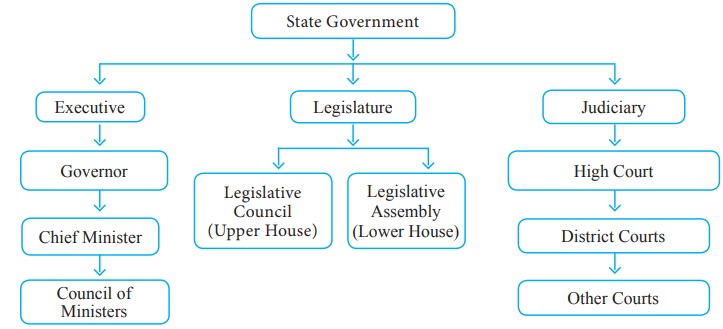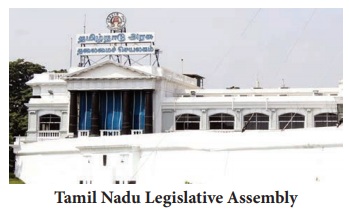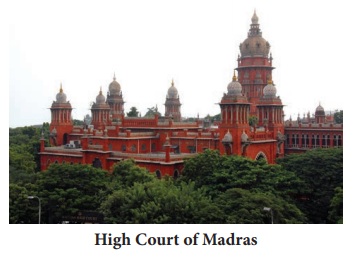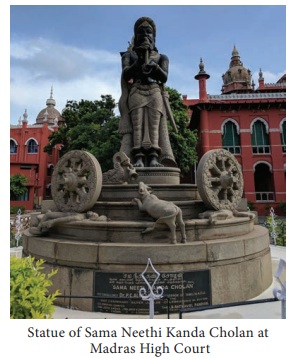Introduction
The Constitution of India envisages for a federal government, having separate systems of administration for the union and the states. There are 28 states, 9 union territories and one national capital territory known as Delhi in India. The constitution contains provisions for the governance of both the union and the states. It lays down a uniform structure for the State Government, in part VI of the constitution from Article 152 to 237, which is applicable to all the states, The structure of the State Government, as formed in the Centre, consists of three branches. These are the Executive, the Legislature and the Judiciary.

The Executive – The Governor
The Governor is the constitutional head of the state executive. Generally, there is a separate Governor in each State but if the situation warrants so, the same person may be appointed as the Governor of two or more States. Article 154 vests the executive power of the State in the Governor.
Appointment of the Governor
The Governor of a State shall be appointed by the President. His usual term of office is five years but he holds office during the pleasure of the President. Generally, the Governor does not belong to the State where he is appointed. He can also be transferred from one state to another by the President. He can also resign any time by addressing his resignation to the President.
The Legislature of a State or a High Court has no role in the removal of a Governor. A person may be appointed as a Governor for any number of terms. Two conventions have been set up in the matter of appointing a person as Governor of a State. He should not be a resident of the State concerned and, the State Government concerned is consulted and its views are sought regarding the proposed choice.
According to Article 158 (3A), where the same person is appointed as Governor of two or more States, the emoluments and allowances payable to the Governor shall be allocated among the States in such proportion as the President may by order determine.
Qualification of the Governor
Article 157 and Article 158 of the Constitution of India specify eligibility requirements for the post of governor. They are as follows:
- He should be a citizen of India.
- He must have completed 35 years of age.
- He should not be a member of Parliament or of any State Legislature. If he is a member of any of Legislature, he automatically vacates his seat on assuming the office.
- He should not hold any other profitable occupation.
Powers and Functions of the Governor
The Governor is the head of the state executive and he has enormous powers. In the exercise of functions and powers, the Governor, except in certain cases, is to be guided by the aid and advice of the Council of Ministers headed by the Chief Minister (under Article 163).
Executive Powers of the Governor
- He appoints the leader of the majority party in the State Legislative Assembly as the Chief Minister of the State.
- He appoints other members of the Council of Ministers on the recommendation of the Chief Minister.
- He appoints the Chairman and Members of the State Public Service Commission.
- He appoints the state election commissioner and determines his conditions of service and tenure of office.
- He acts as the chancellor of universities in the state. He also appoints the Vice Chancellors of universities in the state.
- He directly rules a State when there is the imposition of the President’s rule in the State.
Legislative Powers of the Governor
The Governor is an integral part of the state legislature. But, he is not a member in the either house of the legislature. In this capacity, he enjoys the following legislative powers and functions:
- He has the right to summon, prorogue the state legislature and dissolve the State Legislative Assembly.
- He can address the state legislature at the commencement of the first session after each general election and the first session of each year.
- He can send messages to the houses of the state legislature relating to a bill pending in the legislature.
- He can appoint any member of the Legislative Assembly to preside over its proceedings when the offices of both the Speaker and the Deputy Speaker fall vacant.
- He can nominate one member to the State Legislative Assembly from the Anglo-Indian Community.
- He nominates 1/6 of the members of the State Legislative Council from amongst the persons having special knowledge or practical experience in literature, science, art, cooperative movement and social service.
- Every bill passed by the state legislature will become law only after his signature. But, when a bill is sent to the Governor after it is passed by the legislature, he has the options to give his assent to the bill or withhold his assent to the bill or return the bill for the reconsideration of the legislature.
- He can promulgate ordinances when the state legislature is not in session under Article 213. But, these ordinances must be approved by the legislature within six months. He can also withdraw an ordinance at anytime.
- He has to lay the annual reports of the State Finance Commission, the State Public Service Commission and the Comptroller and Auditor General relating to the accounts of the state, before the state legislature.
Financial Powers of the Governor
- The Constitution confers on the Governor, the duty to get prepared and introduced to the State Legislature, the annual budget and also the supplementary budgets, if necessary.
- Money Bills can be introduced in the Legislative Assembly only with his prior recommendation.
- He can make advances out of the state Contingency Fund to meet any unforeseen expenditure.
- He constitutes a Finance Commission after every five years to review the financial position of the panchayats and the municipalities.
Judicial Powers of the Governor
- He appoints the Attorney-General of the State.
- He makes appointment, postings and promotions of the District Judges in consultation with the State High Court.
- The Chief Justice of the High Court in the State is appointed by the President in consultation with him.
- He can pardon, commute or reprieve punishment on receipt of appeals for mercy except death sentence.
Discretionary Powers of the Governor
- The Governor can reserve a bill for the consideration of the president.
- He can call the leader of any party to form ministry in the state when there is no clear-cut majority to any party in the Legislative Assembly after the general elections.
- He can dismiss the Council of Ministers when it is unable to prove the confidence of the Legislative Assembly; and
Emergency Powers of the Governor
If the Governor is satisfied that the government of the state is not carried on in accordance with the provisions of the Constitution, he may, under Article 356, recommend to the President to impose President Rule in that State. As soon as the President Rule is imposed, the administration of the State is carried on by the Governor as the representative of the President.
Privileges of the Governor
Article 361(1) provides for the following privileges for the Governor;
- The Governor of a State, is not be answerable to any court for the exercise and performance of the powers and duties of his office or for any act done or purporting to be done by him in the exercise and performance of those powers and duties.
- No process for the arrest or imprisonment of the Governor of a State, shall issue from any court during his term of office.
Chief Minister
In the scheme of Parliamentary system of government provided by the constitution, the governor is the nominal executive authority and the Chief Minister is the real executive authority. In other words, the governor is the head of the State while the Chief Minister is the head of the government.
The Appointment of the Chief Minister
The Chief Minister is appointed by the Governor of the State.
The term of the Chief Minister is not fixed. He may remain as the Chief Minister as long as he enjoys the support of the majority of the members of the Legislative Assembly. He has to resign when he losses confidence of the majority in the assembly. It is ‘understood that normally he completes 5 years term like other members in the Legislative Assembly.
Powers and functions of the Chief Minister
Relating to the Council of Ministers
- The Chief Minister recommends the persons who can be appointed as ministers by Governor.
- He allocates the portfolios among the ministers.
- He shuffles and reshuffles his ministry.
- He presides over the meetings of the Council of Ministers and influences its decisions.
- He guides, directs, controls and coordinates the activities of all the ministers.
Relating to the Governor
He advises the Governor in relation to the appointment of the following officials:
- Advocate General of the State.
- State Election Commissioner.
- Chairman and Members of the State Public Service Commission.
- Chairman and Members of the State Planning Commission.
- Chairman and Members of the State Finance Commission.
Relating to State Legislature
- The Chief Minister advises the Governor with regard to the summoning and proroguing the sessions of the state legislature.
- He announces the government policies on the floor of the house.
- He can introduce the bills in the Legislative Assembly.
- He can recommend for the dissolution of the Legislative Assembly to the Governor anytime.
Council of Ministers
The Council of Ministers are collectively responsible to the State Legislature. All the members of the Council of Ministers must be the members of the State Legislature. Those who are not the members at the time of their appointment, must secure their seats in the Legislature within a period of 6 months. If a no-confidence motion is passed by the Legislative Assembly, the State Ministry shall resign.
Article l63 provides for a Council of Ministers to aid and advice the Governor. According to Article 163(1) there shall be a Council of Ministers with the Chief Minister at the head to aid and advice the Governor in the exercise of his functions, except in so far as he is by or under this Constitution required to exercise his functions or any of them in his discretion.
Other Provisions relating to Ministers
Article 164(1) holds that the Chief Minister shall be appointed by the Governor.
Article 164(1A) states that the total number of Ministers, including the Chief Minister, in the Council of Ministers in a State shall not exceed fifteen percent of the total number of members of the Legislative Assembly.
The functions and powers of the Council of Ministers
- It formulates and decides the policies of the state and implements them effectively.
- It decides the legislative programmes of the Legislative Assembly and sponsors all important bills.
- It controls the financial policy and decides the tax structure for the public welfare of the state.
- It makes the important appointments of the Heads of Departments.
- It discusses and takes efforts on the dispute with other states
- It frames the proposal for incurring expenditure out of state reserves.
- It decides all the bills whether ordinary bills or money bills to be introduced in the Legislative Assembly.
- Each minister of the Council of Ministers supervises, controls and coordinates the department concerned.
- Annual Financial Statement called as the Budget is finalised by the Council of Ministers.
The State Legislature
The Constitution provides a legislature for every state. Most of the States have only unicameral legislature i.e., Legislative assembly. Some State has bicameral legislatures (example Bihar, Karnataka, Maharashtra, Uttar Pradesh, Andhra Pradesh and Telangana). The lower house, legislative assembly represents the people of the state the upper house; Legislative Council represents special interests like teachers, graduates and local governments.

In Tamil Nadu, according to the strength of Legislative Assembly (234 members), the number of ministers may be up to 36, i.e. 15 percent of 234.
The Legislative Assembly (Lower House)
The Legislative Assembly is a popular house. It is the real centre of power in the State. It consists of members directly elected by the people on the basis of adult franchise. The strength of the Assembly varies from State to State depending on the population. However the maximum strength of the Assembly must not exceed 500 or its minimum strength not be below 60. The term of office of the legislative assembly is 5 years. It can be dissolved even before the expiry of its term.
The size of the Legislative Council cannot be more than one-third the membership of the Legislative Assembly (lower house) of that state. But its size cannot be less than 40.
Composition
The Legislative Assembly of Tamil Nadu consists of 235 members out of which 234 members are directly elected by the people from the constituencies on the basis of adult franchise and one member is nominated by the Governor from the Anglo-Indian community.
Cabinet and Cabinet Committees
A smaller body called Cabinet is the nucleus of the council of minister. It consists of only the cabinet ministers. It is the real centre of authority in the state government.
The cabinet works through various committees called cabinet committees. They are of two types – standing and ad hoc. The former are of a permanent nature while the latter are of a temporary nature.
The Speaker
The Legislative Assembly elects two of its members as the Speaker and Deputy Speaker. The speaker may be removed from office by a resolution of the Assembly after giving a 14 days’ notice. Such a resolution must be passed by a majority of the members present at the time of voting. The speaker does not vacate his office, when the Assembly is dissolved. He continues to be the Speaker until the first sitting of the new Assembly. While the office of the speaker is vacant, the Deputy Speaker performs his functions.
The Legislative Council (Upper House)
The legislative Council is the upper House of the State Legislature.
The Vidhan Parishads (Legislative Council) forms a part of the state legislatures of India. In Six of India’s 28 states the Legislative Council serves as the indirectly-elected upper house of a bicameral legislature. It is also a permanent house because it cannot be dissolved. Every Member of Legislative Council (MLC) serves for a six-year term, with terms staggered so that the terms of one-third of members expire every two years. MLCs must be citizens of India not under 30 years of age, mentally sound and his name should be in the voter’s list of the state from which he or she is contesting the election.
The Tamil Nadu Legislative Council was abolished by Tamil Nadu Legislative Council (Abolition) Bill, 1986. The Act came into force on the 1st November 1986.
Election to Legislative Council
- 1/3 of the members are elected by local bodies.
- 1/12 of the members are elected by Graduates of the universities in the State.
- 1/12 of the members are elected by Graduate teachers.
- 1/3 of the members are elected by the members of the Legislative Assembly.
- 1/6 is nominated by the Governor who is eminent in the field of literary excellence, art, social services or Co-operation.
The Chairman
The Chairman (chair person he / she) is the Presiding Officer of the Upper house. The Members elect a Chairman and a deputy chairman from among themselves. In the absence of the chairman, the deputy chairman officiate the functions of the Legislative Council.
Abolition or Creation of Legislative Councils
Article 169 deals with the creation or abolition of Legislative Council in a State. Article 169 holds that if the state Legislative Assembly passes a resolution by a majority of not less than 2/3rd of the members present and voting and by the majority of total strength of the House, requesting the Parliament to create or abolish the state Legislative council then the Parliament may by law provide for the abolition and creation of the Legislative Council.
Functions of the State Legislature
Legislative powers
The State Legislature can pass laws on all subjects mentioned in the State List as per the constitution. It can also pass laws on concurrent subjects. The State made law in a concurrent subject will become inoperative when the centre also passes a law on the same subject. The passing of Bill into law follows the same procedure, as in the union parliament. Every bill passes through three readings. Then it becomes an Act with the Governor’s assent.
Financial Powers
The Legislature controls the finances of the State. The Lower House enjoys greater power than the Upper House in money matters. Money bills can be introduced only in the Lower House or the Assembly. No new tax can be levied without the sanction and permission of the Assembly.
Controls over the Executive
The Council of Ministers is responsible to the Assembly. The Ministers have to answer questions asked by the members of the Legislature. They can be removed from office if the Assembly passes a vote of “no confidence motion” against the Ministry.
Judiciary of State
High Courts
The institution of high court originated in India in 1862 when the high courts were set up at Calcutta, Bombay and Madras. In the course of time, each province in British India came to have its own high court. After 1950, a high court existing in a province became the high court for the corresponding state. The High Courts are the highest courts at State level.

The Constitution of India provides for a high court for each state, but the Seventh Amendment Act of 1956 authorised the Parliament to establish a common high court for two or more states or for two or more states and a union territory.
For example, the States of Punjab and Haryana and the Union Territory of Chandigarh have a common High Court situated at Chandigarh. The High Court of Guwahati is common for four northeastern States of Assam, Nagaland, Mizoram and Arunachal Pradesh. The High Court of Guwahati has its benches in Itanagar,
The High Court of Madras is the one of the three High Courts in India established in the three Presidency Towns of Bombay, Calcutta and Madras by letters patent granted by Queen Victoria, bearingdate 26 June 1862. The High Court building is the second largest judicial complex in the world after London.
Kohima and Aizwal. Delhi, though not a State, has its own separate High Court. Every High Court has a Chief Justice and a number of judges. The number of judges varies from State to State. The number of judges of each High Court is determined by the President. At present there are 25 High Courts for 28 States (including new Andhra Pradesh High Court established in 1st January 2019 at principal seat in Amravati) and nine Union Territories.
Jurisdiction and Powers of High Court
Original Jurisdiction
In their judicial capacity, the High Courts of the Presidency towns (Bombay, Calcutta and Madras) have both original and appellate jurisdictions, while other High Courts have mostly appellate jurisdiction.
Only in matters of admiralty, probate, matrimonial and contempt of Court, they have original jurisdiction. The Presidency High Courts have original jurisdiction in which the amount involved is more than ₹2000 and in criminal cases which are committed to them by the Presidency Magistrates.
Appellate Jurisdiction
As Courts of appeal, all High Courts entertain appeals in civil and criminal cases from their subordinate Courts as well as on their own.
They have, however, no jurisdiction over tribunals established under the laws relating to the Armed Forces of the Country.
Writ Jurisdiction
Under Article 226 of the constitution, the High Courts are given powers of issuing writs not only for the enforcement of the Fundamental Rights, but also for other purposes. In exercise of this power, a Court may issue the same type of writs, orders or directions which the Supreme Court is empowered to issue under Article 32.
The jurisdiction to issue writs under this Article is larger in the case of High Courts, for which the Supreme Court can issue them only where a Fundamental Right has been infringed, a High Court can issue them not only in suchcases, but also where an ordinary legal right has been infringed. It has the power to issue the five kinds of Writs like Habeas Corpus, Mandamus, Prohibition, Quo Warranto, Certiorari.
Supervisory Jurisdiction
High court has the power of superintendence over all courts and tribunals functioning in its territorial jurisdiction (except military courts or tribunals) Thus, it may
- Call for returns from them;
- Make an issue, general rules and prescribe forms for regulating the practice and proceedings of them.
- Prescribe forms in which books, entries and accounts are to be kept by them; and
- Settle the fees payable to the sheriff, clerks, officers and legal practitioners of them.
Court of Record
All the decisions and decrees issued by the High Court are printed and are kept as a record for future references by the Court as well as by the lawyers, is such a need arises. Thus, it also acts as a Court of Record.










